

Understanding Camera Lenses. Understanding camera lenses can help add more creative control to digital photography.
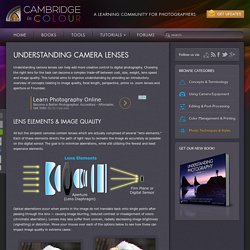
Choosing the right lens for the task can become a complex trade-off between cost, size, weight, lens speed and image quality. This tutorial aims to improve understanding by providing an introductory overview of concepts relating to image quality, focal length, perspective, prime vs. zoom lenses and aperture or f-number. All but the simplest cameras contain lenses which are actually comprised of several "lens elements. " Each of these elements directs the path of light rays to recreate the image as accurately as possible on the digital sensor. The goal is to minimize aberrations, while still utilizing the fewest and least expensive elements. Optical aberrations occur when points in the image do not translate back onto single points after passing through the lens — causing image blurring, reduced contrast or misalignment of colors (chromatic aberration).
Original Image ZOOM LENSES vs. Cambridge in Colour - Photography Tutorials & Learning Community. Understanding Camera Lens Flare. Lens flare is created when non-image forming light enters the lens and subsequently hits the camera's film or digital sensor.
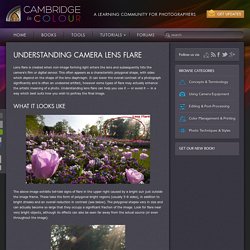
This often appears as a characteristic polygonal shape, with sides which depend on the shape of the lens diaphragm. It can lower the overall contrast of a photograph significantly and is often an undesired artifact, however some types of flare may actually enhance the artistic meaning of a photo. Understanding lens flare can help you use it — or avoid it — in a way which best suits how you wish to portray the final image. The above image exhibits tell-tale signs of flare in the upper right caused by a bright sun just outside the image frame. These take the form of polygonal bright regions (usually 5-8 sides), in addition to bright streaks and an overall reduction in contrast (see below). Flare can take many forms, and this may include just one or all of the polygonal shapes, bright streaks, or overall washed out look (veiling flare) shown above.
Composition: Using the Rule of Thirds. The rule of thirds is a powerful compositional technique for making photos more interesting and dynamic.
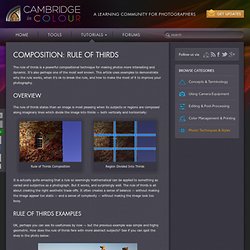
It's also perhaps one of the most well known. This article uses examples to demonstrate why the rule works, when it's ok to break the rule, and how to make the most of it to improve your photography. Compact vs. Digital SLR Cameras. Choosing between a compact (or "point and shoot") and a digital SLR camera is often the first big purchasing decision when starting out with photography.

Not only is it potentially a big financial decision, but it may also determine what kinds of shots you'll be capable of capturing. This tutorial cuts through all the marketing hype in order to highlight only the most important differences between each camera type — thereby helping you to decide which one is best for you and your shooting style. What exactly does it mean for a camera to be a compact (or point and shoot) versus an SLR? Strictly speaking, SLR cameras just have viewfinders that see the same light as the camera's sensor (more on this later), but in practice this isn't the only distinction. While the line between each continues to blur, these three differences usually* still apply: Viewfinder MechanismFixed vs. 2. Why would a camera need more than one lens?
In practice, being able to use different lenses usually means that: Camera Exposure: Aperture, ISO & Shutter Speed. A photograph's exposure determines how light or dark an image will appear when it's been captured by your camera.
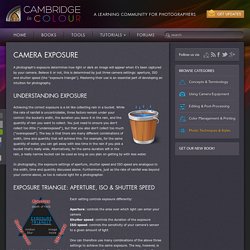
Believe it or not, this is determined by just three camera settings: aperture, ISO and shutter speed (the "exposure triangle"). Mastering their use is an essential part of developing an intuition for photography. Achieving the correct exposure is a lot like collecting rain in a bucket. While the rate of rainfall is uncontrollable, three factors remain under your control: the bucket's width, the duration you leave it in the rain, and the quantity of rain you want to collect.
You just need to ensure you don't collect too little ("underexposed"), but that you also don't collect too much ("overexposed"). In photography, the exposure settings of aperture, shutter speed and ISO speed are analogous to the width, time and quantity discussed above. Each setting controls exposure differently: By the Numbers.
Understanding Depth of Field in Photography. Depth of field refers to the range of distance that appears acceptably sharp.
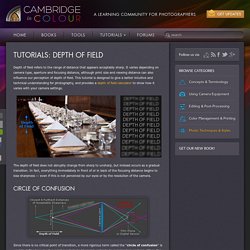
It varies depending on camera type, aperture and focusing distance, although print size and viewing distance can also influence our perception of depth of field. This tutorial is designed to give a better intuitive and technical understanding for photography, and provides a depth of field calculator to show how it varies with your camera settings. The depth of field does not abruptly change from sharp to unsharp, but instead occurs as a gradual transition. Digital Cameras - Digital Video Cameras – DSLR Cameras. Images from Timpanogos. Entry Assignment: Parts of A Film SLR Camera - Advanced Photography Blog - Photography 2 - Issaquah Connect.
Entry Assignment: Parts of A Film SLR Camera - Advanced Photography Blog - Photography 2 - Issaquah Connect. DSLR Camera: Parts and Controls. Getting To Know Your Camera Take a few minutes to make yourself familiar with parts and controls of your camera.
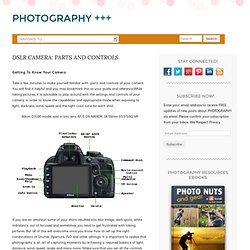
You will find it helpful and you may bookmark this as your guide and reference.While taking pictures, it is advisable to play around with the settings and controls of your camera, in order to know the capabilities and appropriate mode when exposing to light, darkness, wind, speed and the right color tone for each shot. Nikon D3100 model sold in kits; lens AF-S DX NIKKOR 18-55mm f/3.5-5.6G VR If you are an amateur, some of your shots resulted into blur image, dark spots, white imbalance, out of focused and sometimes you tend to get frustrated with taking pictures. But all of this will overcome once you know how to set up the right combinations of Shutter, Aperture, ISO and other settings. In an actual scenario, we don’t have enough time to setup the controls and settings to get an excellent shot. FollowAnthony Lucas on Google+! Guide... Digital SLR cameras have improved dramatically over recent years, they have also become much cheaper.

Consumers can now buy an entry level digital SLR for around the same price as a top of the range compact. This paper explains the difference between a digital compact and digital SLR and shows how to get the most out of this type of camera. 1. Introduction The world of digital photography has evolved dramatically over the last decade. SLR Camera parts.